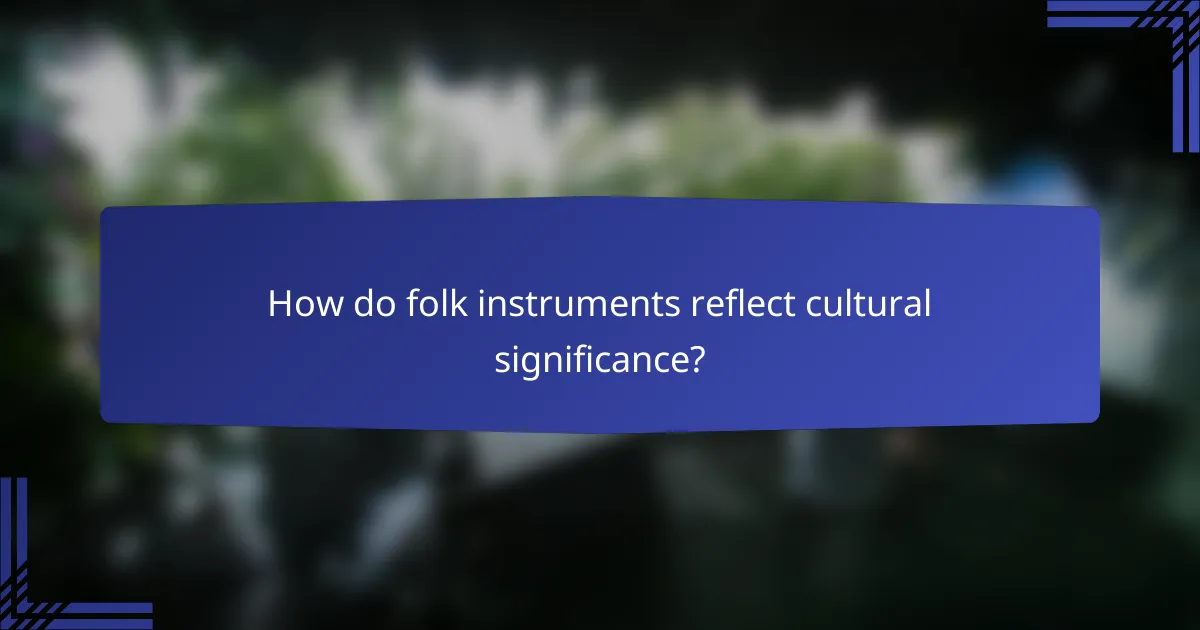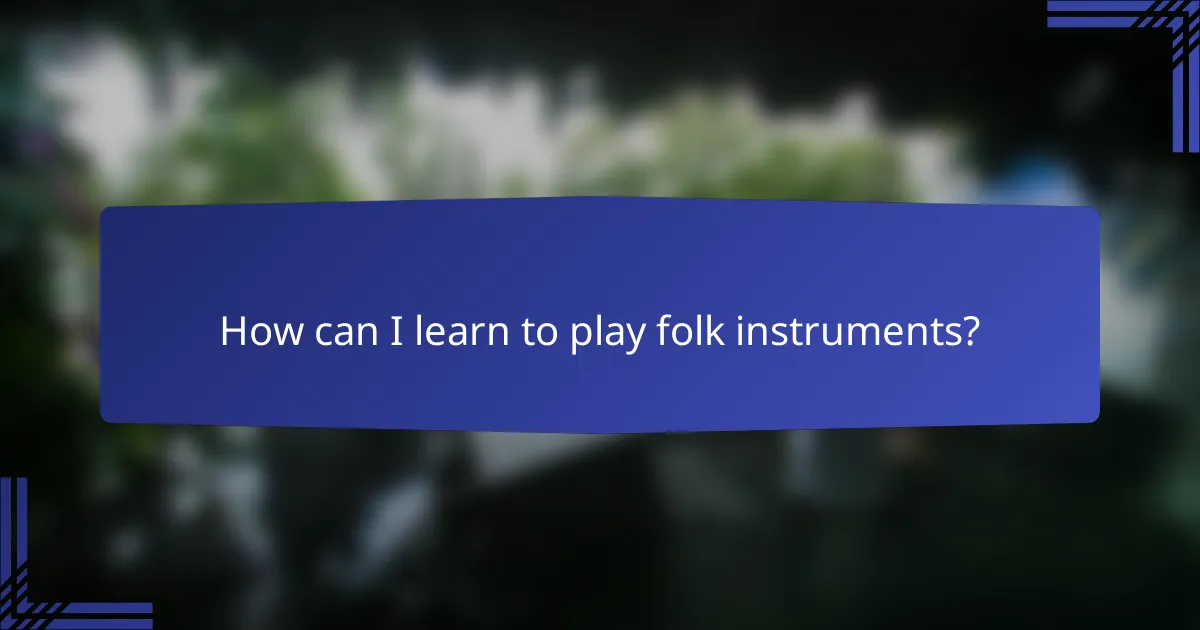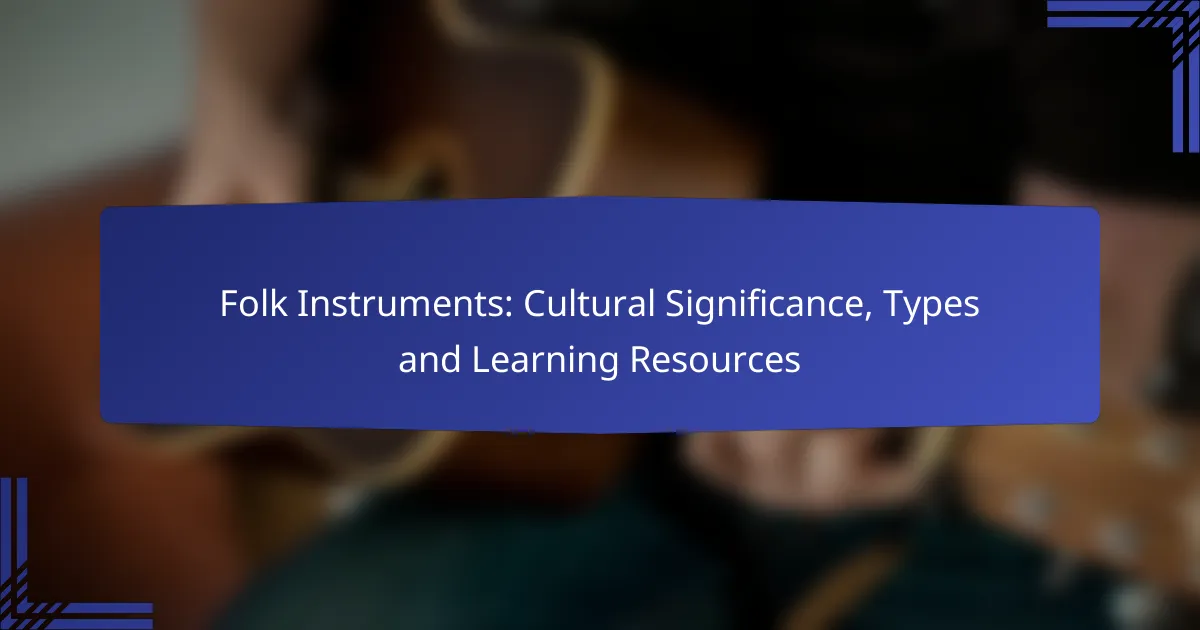Folk instruments play a vital role in preserving cultural heritage and expressing the unique identities of communities worldwide. From string instruments like the banjo and fiddle to wind and percussion types, each instrument carries its own significance and storytelling tradition. Learning about these instruments not only enriches our understanding of music but also connects us to the diverse cultures they represent.

What are the most popular folk instruments in the United States?
The most popular folk instruments in the United States include the banjo, mandolin, guitar, fiddle, and accordion. Each instrument has a unique cultural significance and playing style, contributing to the rich tapestry of American folk music.
Banjo
The banjo is a stringed instrument with a circular body and a long neck, known for its bright, twangy sound. It is commonly associated with bluegrass and folk music, often played in a fingerpicking style. Beginners should consider starting with a 5-string banjo, which is the most popular type.
When learning the banjo, focus on basic rolls and chords to build a solid foundation. Many resources are available, including online tutorials and local music schools. Joining a community group can also enhance your learning experience.
Mandolin
The mandolin is a small, stringed instrument resembling a lute, typically with eight strings paired in courses. Its sharp, bright tone makes it a favorite in bluegrass and traditional folk music. The instrument is often played using a plectrum for quick, rhythmic strumming.
For beginners, mastering simple chords and melodies is essential. Consider using instructional books or online classes to guide your practice. Regularly playing with other musicians can also help improve your skills and musicality.
Guitar
The guitar is one of the most versatile folk instruments, available in acoustic and electric forms. It serves as a backbone for many folk songs, providing harmony and rhythm. Acoustic guitars are particularly popular for traditional folk music due to their warm sound.
When learning guitar, start with basic chords and strumming patterns. Practice regularly, and consider using apps or online lessons for structured learning. Playing along with recordings can help develop timing and ear training.
Fiddle
The fiddle, essentially a violin played in a folk style, is central to many American folk traditions, especially in Appalachian music. It is known for its expressive sound and ability to convey a wide range of emotions. Fiddlers often use various techniques, such as double stops and slides, to enhance their playing.
To learn the fiddle, focus on bowing techniques and ear training. Joining a local fiddle group or taking lessons can provide valuable feedback and support. Regular practice is crucial for developing the necessary skills and confidence.
Accordion
The accordion is a free-reed instrument that produces sound by forcing air through reeds, making it popular in folk music across various cultures. In the United States, it is often associated with Cajun and polka music. The instrument has a distinctive sound and can play melody and harmony simultaneously.
When starting with the accordion, familiarize yourself with the bellows and keyboard layout. Basic lessons focusing on scales and simple songs can help you progress. Consider attending workshops or finding a mentor to enhance your learning experience.

How do folk instruments reflect cultural significance?
Folk instruments embody the cultural significance of a community by preserving traditions, stories, and identities. They serve as a medium for expressing the unique characteristics of a culture, often passed down through generations.
Connection to heritage
Folk instruments are deeply intertwined with the heritage of a community, often representing historical narratives and local customs. For instance, instruments like the Irish uilleann pipes or the Indian sitar are not just musical tools; they are symbols of cultural identity and pride.
Learning to play these instruments often involves understanding the stories and traditions behind them, fostering a deeper connection to one’s roots. This connection can be vital for cultural preservation, especially in regions where globalization threatens local customs.
Role in community events
Folk instruments play a crucial role in community events, serving as the backbone of celebrations, rituals, and gatherings. They are often featured in festivals, weddings, and religious ceremonies, enhancing the communal experience through music.
For example, the use of the balalaika in Russian folk festivals or the banjo in Appalachian gatherings highlights how these instruments bring people together, creating a shared sense of belonging and joy.
Influence on regional music styles
Folk instruments significantly influence regional music styles, shaping the soundscapes of various cultures. Each instrument contributes unique tonal qualities and playing techniques that define the music of a particular area.
Instruments like the African djembe or the Brazilian berimbau not only reflect their cultural origins but also inspire contemporary genres, blending traditional sounds with modern influences. This fusion often leads to innovative musical expressions that resonate with both local and global audiences.

What are the key types of folk instruments worldwide?
Folk instruments can be broadly categorized into three main types: string, wind, and percussion instruments. Each type has unique characteristics and cultural significance, reflecting the traditions and practices of various communities around the globe.
String instruments
String instruments are characterized by their use of vibrating strings to produce sound. Common examples include the guitar, violin, and banjo, each with regional variations that highlight local craftsmanship and musical styles. These instruments can be played by plucking, bowing, or strumming, making them versatile for different genres.
When learning string instruments, consider starting with a simpler model to build foundational skills. For instance, a basic acoustic guitar can be more accessible for beginners than a complex classical guitar. Regular practice and familiarity with basic chords can significantly enhance your playing ability.
Wind instruments
Wind instruments produce sound by the vibration of air within a tube or pipe. Examples include flutes, clarinets, and bagpipes, each offering distinct tonal qualities and playing techniques. Many cultures have developed unique wind instruments that reflect their musical heritage and social practices.
To learn a wind instrument, focus on breath control and proper technique. Beginners should start with instruments that have a more forgiving learning curve, such as recorders or simple flutes. Regular practice of scales and simple melodies can help develop both technique and confidence.
Percussion instruments
Percussion instruments create sound through striking, shaking, or scraping. This category includes drums, tambourines, and maracas, which are integral to many folk music traditions. Their rhythmic qualities often drive the tempo and energy of musical performances.
When learning percussion instruments, start with basic rhythm exercises to develop timing and coordination. Instruments like hand drums or cajóns are great for beginners due to their intuitive playing style. Engaging in group drumming sessions can also enhance your skills and provide a sense of community.

How can I learn to play folk instruments?
Learning to play folk instruments can be an enriching experience, and there are various methods to get started. Consider online courses, local workshops, and instructional books as effective resources to develop your skills.
Online courses
Online courses offer flexibility and a wide range of options for learning folk instruments. Platforms like Udemy, Coursera, and Skillshare provide structured lessons that cater to different skill levels, from beginners to advanced players.
When selecting an online course, look for those that include video demonstrations, downloadable resources, and community forums for interaction. Many courses charge between $10 to $200, depending on the depth and duration of the content.
Local workshops
Local workshops are a great way to learn folk instruments in a hands-on environment. Check community centers, music schools, or folk festivals for workshops that focus on specific instruments or styles.
Participating in a workshop allows you to receive immediate feedback from instructors and connect with fellow learners. Costs can vary widely, typically ranging from $20 to $100 per session, depending on the instructor’s expertise and the duration of the workshop.
Instructional books
Instructional books provide a solid foundation for learning folk instruments at your own pace. Look for books that include clear illustrations, exercises, and song examples relevant to the instrument you wish to learn.
Popular titles often range from $15 to $50 and can be found at local bookstores or online retailers. Additionally, consider checking your local library for a selection of instructional materials to explore different styles without the upfront cost.

What are the best online resources for learning folk instruments?
Some of the best online resources for learning folk instruments include dedicated websites, video platforms, and mobile applications that offer lessons, tutorials, and community support. Popular platforms like YouTube, Udemy, and specialized sites such as Folk Music Academy provide a range of instructional materials suitable for beginners to advanced players.
Websites and Online Courses
Websites like Folk Music Academy and ArtistWorks offer structured courses with video lessons, sheet music, and practice exercises tailored to various folk instruments. These platforms often feature experienced instructors who guide learners through techniques and styles specific to folk music.
Additionally, sites like Coursera and Udemy provide courses that cover not only instrument techniques but also the cultural context of the music, enhancing the learning experience. Look for courses that include community forums for peer support and feedback.
YouTube Channels
YouTube is a treasure trove of free instructional videos for folk instruments. Channels such as The Acoustic Guitarist and Folk Music Lessons provide tutorials ranging from basic chords to advanced techniques. These videos often include play-along sessions and tips from seasoned musicians.
When using YouTube, consider subscribing to channels that regularly update their content and engage with their audience. This ensures access to a variety of learning materials and styles.
Mobile Applications
Mobile applications like Yousician and Simply Guitar offer interactive lessons for folk instruments, allowing users to learn at their own pace. These apps often include features like real-time feedback on playing, which can be particularly helpful for beginners.
Look for apps that provide a mix of song tutorials, exercises, and challenges to keep your practice engaging. Many of these applications offer free trials, so you can explore their offerings before committing to a subscription.
